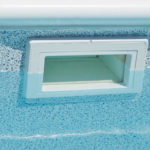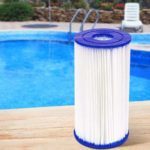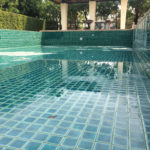Use the bucket test. Fill the pool to a normal level and fill a 5-gallon bucket about a third full of pool water. Mark the water level on the inside of the bucket and the pool level on the outside (shut off the pump when you do it and then resume normal operation). After 24 hours compare the two. If the pool water mark on the outside of the bucket goes down more than the bucket water, there is probably a leak. If the levels changed the same amount it is evaporation.
CDC recommends:
Follow these steps to remove formed poop or diarrhea and disinfect the water:
- Close the pool to swimmers.
- Put on disposable gloves.
- Remove the poop using a net or bucket. Do not vacuum the poop from the pool.
- Clean as much poop as possible from the item used to remove the poop and dispose of it in a sanitary manner.
- Disinfect the item used to remove the poop by immersing it in the pool during the 30-minute disinfection time described below.
- Remove and dispose of gloves
- Wash your hands thoroughly with soap and water.
- Raise the free chlorine concentration to, or maintain it at, 2 parts per million (ppm) and maintain the pH at 7.5 or less for 30 minutes.
- Confirm that the filtration system is operating properly.
For public pools, the pool operator should raise the free chlorine concentration very high for hours if someone has diarrhea in the pool since it might contain the chlorine tolerant parasite Cryptosporidium. This recommendation does not apply to residential pools. Members of one family or the same household are less likely to spread Cryptosporidiumto each other if they use the same pool. Additionally, raising the free chlorine concentration very high for hours increases the risk of pool chemical injuries to residential pool owners (for example, respiratory distress or chemical burns) if the pool chemicals are mishandled. This means it is very important for swimmers to follow the steps of healthy swimming whether they use public or residential pools.
A strong chlorine smell, contrary to what may seem logical; often means chlorine needs to be added. High levels of chloramines emit a strong chlorine smell, and chloramines form when chlorine interacts with introduced contaminants, like sweat and body oil. In this scenario, chlorine needs to be added to sanitize the water and get rid of the chloramines.
Yes. Your pump should turn over the water through your filter in your pool at least once per day, 8 hours a day.
Chlorine is added to the water to kill germs. But it does not work right away. If used properly, free chlorine* can kill most germs within a few minutes. CDC recommends pH 7.2–7.8 and a free chlorine concentration of at least 1 ppm in pools.
* Free available chlorine is the more active form of chlorine that kills germs.
First, as pH goes up, the ability of free chlorine to kill germs decreases, especially if pH is >8.0. Second, as pH goes down, especially if pH is <7.0, the ability of free chlorine to kill germs increases but the pool pipes are more likely to corrode or break down. Third, keeping the pH in the 7.2–7.8 range helps keep swimmers comfortable in the water by helping to prevent eye and skin irritation. This means keeping the pH in the 7.2–7.8 range best balances killing germs to prevent recreational water illness, the lifespan of the pipes, and swimmers’ comfort.
All sorts of things can reduce chlorine concentration in pool water. Free available chlorine breaks down pee, poop, sweat, and dirt from swimmers’ bodies instead of killing germs and uses up chlorine, which means there is less to kill germs. The sunlight and hot tub/spa jets creating droplets or mists from the water also uses up free chlorine. That’s why the free chlorine concentration must be routinely tested. And remember, the time it takes for free chlorine to kill germs is also affected by the other member of the disinfection team, pH.







